Florida State had a football team from 1902 to 1904. From 1905 through 1946, it was a women’s college and, therefore had no intercollegiate football. In 1947, the institution again became co-educational and immediately began playing intercollegiate football, again. I was fortunate to be among the nearly eight thousand at Centennial Field in Tallahassee on October 18, 1947, when Florida State played its first game, a 6-14 loss against Stetson, in what may be called the “modern era.” Since 1947, I have seen lots of FSU football games.
During the years, I have enjoyed each football season. In retrospect, these are the ten seasons that were the most fun for me.
1947. Of course, I have to list the first season as it was so special to have FSU playing intercollegiate football in my own hometown. As a thirteen year old, I thought that was wonderful. The team only played five games (four of them in Tallahassee) under Coach Ed Williamson and lost them all, but came close to winning a couple. The team was mainly made up of World War II military veterans who came back to college to finish their educations. The games at Old Centennial always included a couple of trains passing by to add to the festivities.
1950. Although, FSU competed at the small college level in which no athletic scholarships were available, the Seminoles had their first ever undefeated team, when they went 8-0 and won the Dixie Conference for the third year in a row. Don Veller was the head coach. Major events of the season included the move to the new Doak Campbell Stadium and the adoption of the FSU fight song. Tommy Brown’s 82-yard punt in the game against Tampa was something to see and is still the school record in that category.
1954. Tom Nugent was the head coach and the team did well enough (8-3 record) during the regular season to obtain a bid and play in the Sun Bowl at the end of the season. Although, they lost the game to Texas Western it created quite a stir as it was the first time ever that a team from the Florida played in a bowl game outside the state. Interesting stories continue to circulate to this day about the antics of two of that team’s most famous players, Lee Corso and Burt (“Buddy”) Reynolds, on that bowl trip.
1964. The 1964 team coached by Bill Peterson is one of FSU’s most famous. It featured a passing combination of quarterback Steve Tensi and FSU’s first consensus All-American, Fred Biletnikoff, as well as a great defense composed of the Seven Magnificents (linemen and linebackers) and the Forgotten Four (backs). Coach Peterson was a pioneer in college football by featuring an offense built around the forward pass. The team finished the year by defeating Oklahoma 36-19 in the Gator Bowl and going 9-1-1. That season included two other very special games when FSU defeated national number five Kentucky, 48-6, at its homecoming, and beat the University of Florida for the first time in the modern era, 16-7.
1967. Kim Hammond to Ron Sellers was the passing combination that led this team to a 7-2-2 record including a 17-17 tie with Joe Paterno’s Penn State team in the Gator Bowl. The season included the sensational 37-37 tie with the Alabama Crimson Tide at Legion Field in Birmingham as well as the 21-16 victory at the University of Florida. In the Florida game, Hammond was knocked unconscious in the first half and returned late in the game to lead a touchdown drive, passing to Sellers, to ensure victory.
1971. In Coach Larry Jones’ first season at FSU, the team was quite successful in going 8-3 during the regular season and playing in the first ever Fiesta Bowl. The team featured quarterback Gary Huff, All-American wide receiver Barry Smith, and defensive backs J.T. Thomas and Eddie McMillan as well as several others that would later play in the National Football League. The Fiesta Bowl game was an aerial contest between FSU quarterback Huff and Arizona State’s Danny White, both of whom would have successful NFL careers. Arizona State won that game 45-38 in a game that came down to “who had the ball last” scenario.
1977. In Bobby Bowden’s second year at the helm of the FSU football program, the team went 10-2 including a 40-17 victory over Texas Tech in Orlando’s Tangerine Bowl and finished the year being ranked 14th in the nation by the Associated Press. The team featured running back Larry Key and freshman nose guard Ron Simmons, as well as the famed “two-headed quarterback” tandem of Jimmy Jordan and Wally Woodham. Fans would jingle car keys each time Key ran the ball. A special victory in the last game of the regular season was the one over the University of Florida at their place, 37-9.
1993. FSU won its first ever National Championship when it beat Nebraska in the Orange Bowl, 18-16. Charlie Ward also became the first Seminole to win the Heisman Trophy as the best player in college football. The season included a number of highlights. They included the opening game Kickoff Classic goal line stand against Kansas in the New York Metropolitan area in which the defense stopped the Jayhawks on six consecutive plays within the Seminole one yard line and the final fourth quarter events in the championship game in Miami’s Orange Bowl at the end of the season when the championship was won. FSU made its field goal and Nebraska missed its.
1999. FSU had a perfect season in 1999 winning all of its games. From the very first poll of the year through the last, FSU was in first place. The National Championship was won in the Sugar Bowl when FSU defeated Virginia Tech, 46-29. Quarterback Chris Weinke, who would win the Heisman Award the following season, was sensational all season long as was wide receiver, Peter Warrick. Warrick’s heroics was primary in saving the day in the championship game against Virginia Tech and its famed quarterback, Michael Vick.
2013. A list of ten special seasons must include the immediate past season in which Heisman winning freshman quarterback Jameis Winston and a host of other outstanding players led the Seminoles to another undefeated season and a third national championship. The 14-0 season included blowout wins over rivals Clemson (51-14), N.C. State (49-17), Miami (41-14), and Florida (37-7) as well as a last moment come from behind national championship game victory over Auburn (34-31) in Pasadena’s famous Rose Bowl Stadium.
 Program Cover |
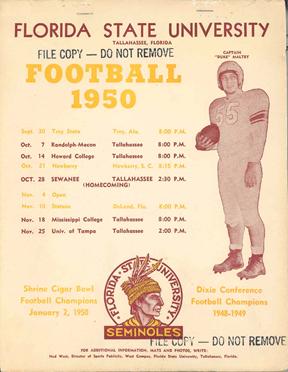 Guidebook Cover |
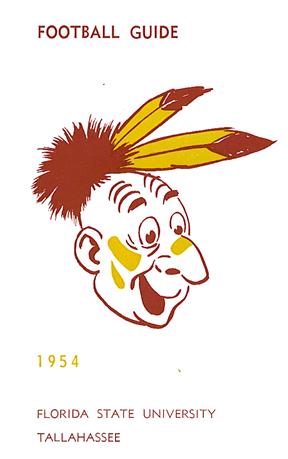 Press Guide Cover |
 Handbook Cover |
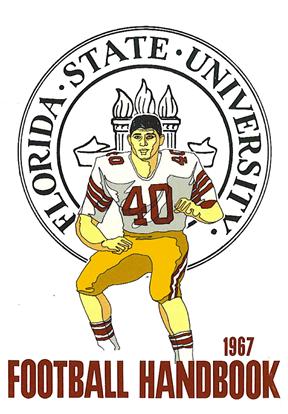 Handbook Cover |
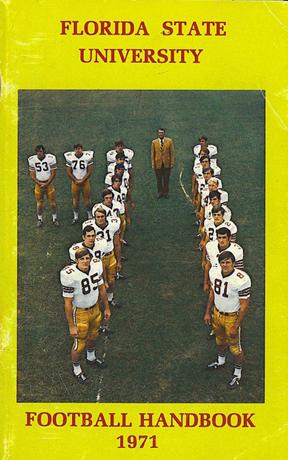 Handbook Cover |
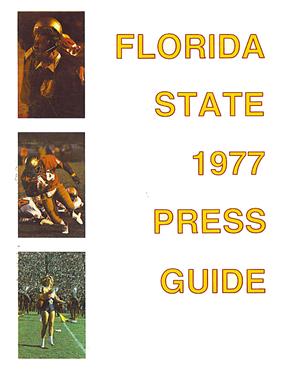 Press Guide Cover |
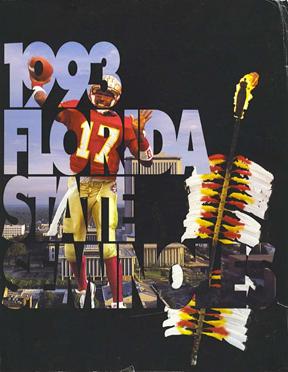 Media Guide Cover |
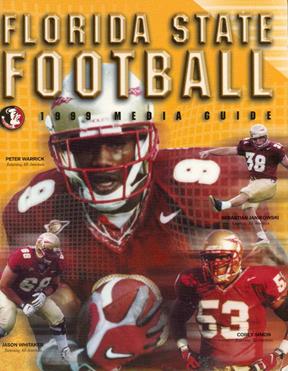 Media Guide Cover |
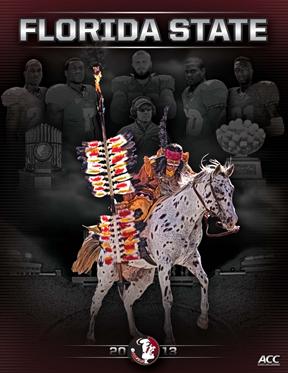 Media Guide Cover |